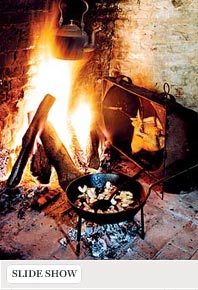
PAST
Owner: Retired naval captain John Neville
Took possession in: 1770s
In the 1800s, it was home to Judge Jacob Tysen, who used the downstairs as a courtroom.
PRESENT
Owner: Mark Landis
Bought house in: 1995
He’s got electricity and running water but no central heat; in cold weather, he sleeps with a wool hat on.
There was a moment of doubt watching Mark Landis prepare a meal, eighteenth- century style, in the fireplace of his dining room. The chicken was on a spit in the circa-1770 reflector oven, and the sliced apples, bacon, and Brussels sprouts were starting to sizzle in the spider pan over the fire’s embers, and crumpets were baking in the coals—but would it all be ready for lunch? And would an antique oven really cook the chicken through?
Not that there should be any doubt. Landis, a former retail-display artist with the life skills of a Colonial settler, has lived in this three-story pre–Revolutionary War stone house for eleven years essentially as if he were living in the eighteenth century (although there is running water and electricity, it’s heated only by the fireplace and a nineteenth-century kitchen stove). He’s restored it pretty much single-handedly, so throwing together lunch over an open flame is nothing.
Always history-obsessed, he’d been living in a (haunted) nineteenth-century house on Broome Street, with no desire to move. But then he found the Staten Island property and gave in completely to his fascination with the era. And though its layout was suffering the indignities of a few centuries of repurposing (chopped-up rooms, shag carpet), its elegant Colonial bones were fully intact.
The first recorded tenant here was Captain John Neville, a retired naval officer, who took possession in the 1770s. In the 1800s, it was the home of Judge Jacob Tysen (who had his courtroom in the downstairs parlor) and was renowned for its beautiful gardens. Later incarnations included a tavern and a hotel.
By the time Landis bought it, the interior had been cut into separate apartment units; the floors were covered by layers of wall-to-wall, the original beams by dropped ceilings. But he had an idea of what lay beneath. “There were enough bits and pieces showing,” he says. Listening to Landis talk his way through the house is a crash course in Colonial living. The bricks of the fireplace, each of a different shape and color, were clearly recycled, he says, from other houses. The fireplace opening’s arc shape was designed to help heat radiate. The exposed laths in the entrance-hall walls show how each slender piece of wood was hand-split, and each irregular nail head shows its handmade origins. The finely smoothed ceiling beams downstairs were meant to be exposed, allowing heat to travel up through the house more easily, while the rough, “undressed” beams upstairs would have been plastered over to hold the heat more efficiently. The ladies’ parlor has a fireplace and narrow floorboards—quite fashionable in the eighteenth century.
When Landis began digging into one part of the parlor where pocket doors had been put in, he peeled back layer upon layer of wallpaper, strata of décor that ran from the late 1700s to the mid-nineteenth century.
Not surprisingly, Landis now works as a guide at Historic Richmond Town, where he teaches schoolchildren about housekeeping and homesteading in the eighteenth century. Many of them are bored and resentful at first, he says. But halfway through, “suddenly they’re interested. For most people, it’s very difficult to perceive what life must have been like then.”
There may not have been central heat, but if lunch that day is any indication—perfectly crisp chicken, tender vegetables, and crumpets warm from the fire—life on Staten Island 200 years ago wasn’t so bad.
